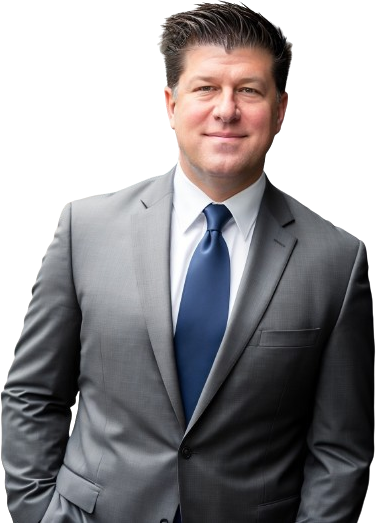
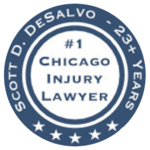

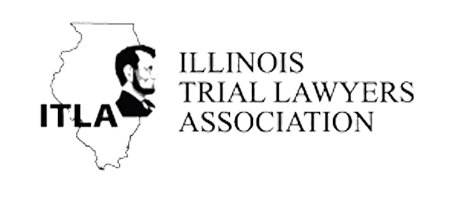
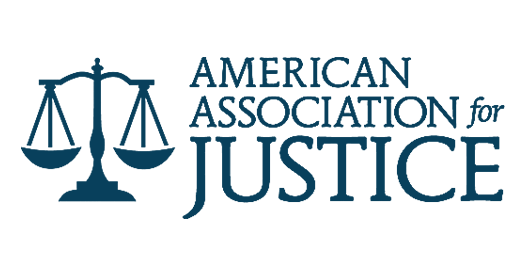
If you've been hurt in a car accident anywhere in Chicago, you need a car accident lawyer who treats you like family—not like a file number. I'm Scott DeSalvo, and about three years ago, I got a call from a family over in Logan Square. Their daughter got rear-ended by some guy texting on the Kennedy during rush hour. Bad crash. Whiplash, concussion, busted wrist.
But here's what really got me—her mom said the insurance company was already blowing up their phone. Offering them a couple grand to settle. Thing is, they hadn't even gotten all the medical bills yet. Didn't know how bad the injuries really were. Just knew the insurance company wanted them to sign papers fast.
That call reminded me why I do this.
When I was 9, my dad got catastrophically injured at work. He was a Teamster. Drove trucks. Strong guy who took care of us. That injury took everything from him. But you want to know what made it worse? His lawyer. The guy didn't fight for him. Let the case drag on for 17 years. Then—get this—sued my dad for more fees at the end.
I saw what that did to my family. And I promised myself that would never happen to anyone I represent. Ever.
So if you got hurt in a car accident anywhere in Chicago—on Lake Shore Drive, the Dan Ryan, some side street in Wicker Park, parking lot in the Loop, doesn't matter where—you need someone who'll actually fight for you. Someone who treats you like family, not like a file number.
That's what I do.
I'm Scott DeSalvo. I've handled thousands of car accident cases all over Chicago. Recovered millions for my clients. More important than that? I only represent injured people. Never insurance companies. Never the other side. Your fight is my fight.
Call me right now. (312)-500-4500. Any time. Day, night, 2am, Sunday, Christmas, doesn't matter. The call's free. We'll talk like friends. No pressure, no BS. Just straight answers.

Look, Chicago isn't like other cities. Our roads beat you up. The Kennedy's a parking lot at rush hour with angry drivers. The Dan Ryan? Forget about it. The Eisenhower's just as bad. And Lake Shore Drive has its own special dangers—tourists who don't know where they're going, weather that changes in five minutes, curves that catch people off guard.
I've represented accident victims from every part of this city. Lincoln Park. Hyde Park. Bridgeport. Pilsen. Lakeview. South Shore. Every neighborhood has its own problems.
Our winters? Brutal. Ice, snow, that black ice you can't even see. Causes thousands of crashes every year. Half the drivers don't know how to handle winter conditions.
Construction everywhere. Always. Road work, buildings going up. Construction zones all over the place creating lane shifts and confused drivers.
Distracted drivers. I can't tell you how many cases I've handled where someone was on their phone instead of watching the road. Texting. Scrolling through Instagram. Messing with their GPS. Not paying attention.
Drunk drivers. Still a huge problem in Chicago. Especially late at night on weekends.
And the insurance companies? They know all this. They use it against you. Try to blame you for the accident. Say you were driving too fast. Claim your injuries aren't that bad.
That's why you need me. I know every trick they use. And I know how to beat them.
I handle all kinds of car accident cases. Large or small, I handle them all.
Rear-end crashes. Happen constantly on Chicago highways during rush hour. Traffic stops, someone's not paying attention, BOOM. Insurance companies love to say rear-end accidents aren't serious. They're wrong.
Head-on collisions. These are bad. Really bad. Usually happen when someone crosses the center line or goes the wrong way. I've handled these all over Chicago. Almost always result in serious injuries.
T-bone accidents. Side-impact crashes at intersections when someone runs a red light or doesn't yield. The impact on the side of your car can be devastating.
Multi-car pile-ups. The Kennedy in winter? Recipe for disaster. These involve multiple cars and figuring out who's at fault gets complicated fast.
Hit-and-runs. Happen way too often in Chicago. Someone hits you and takes off. These cases are tough because we have to use your own insurance, and they make it difficult.
Parking lot accidents. Don't let anyone tell you these don't matter. I've seen serious injuries from crashes in grocery store parking lots, shopping centers, parking garages all over the city.
Uber and Lyft accidents. These are complicated because of how the insurance works. Whether you're a passenger, another driver, or a pedestrian, rideshare accidents have special rules.
Drunk driving accidents. When someone drunk hits you, you might get punitive damages on top of regular compensation. I go hard after drunk drivers.
Intersection accidents. Chicago intersections are dangerous. People running red lights, not yielding, getting confused about who goes when. Seen it all.
Whatever happened in your crash, if you got hurt and it wasn't your fault, call me. (312)-500-4500. Let's talk.
Most people don't know this, but you're entitled to way more than just medical bills. Let me break it down:
Medical expenses. Everything. ER, ambulance, hospital, surgery, physical therapy, chiropractor, drugs. Not just what you already spent—what you'll need down the road too.
Lost wages. Every day you missed work. If you had to burn through sick days or vacation, that counts.
Lost earning capacity. If you can't go back to your old job or can only work part-time now, I get you the difference.
Pain and suffering. The actual physical pain. The emotional crap. The frustration of not being able to do what you used to do. This is real under Illinois law.
Property damage. Your car repair or replacement. Rental car while yours is in the shop.
Loss of enjoyment of life. Can't play with your kids like before? Can't do your hobbies? That matters.
Scarring. Permanent scars affect your life and how you feel about yourself.
Loss of consortium. For your spouse—how your injuries affected your relationship.
In cases where the other driver was drunk or super reckless, I go after punitive damages too.
Here's what insurance companies do. They lowball you. Offer you a quick settlement that doesn't cover your first month of medical bills. They're betting you don't know better.
Don't fall for it. Call me first. (312)-500-4500. Let me tell you what your case is actually worth.
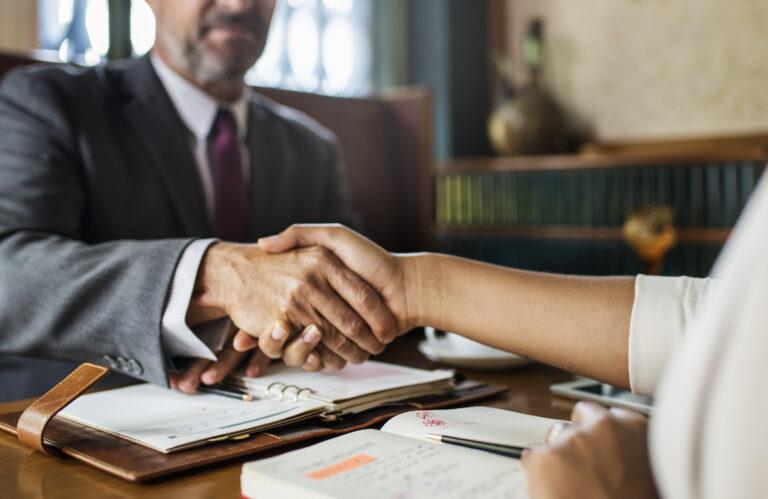

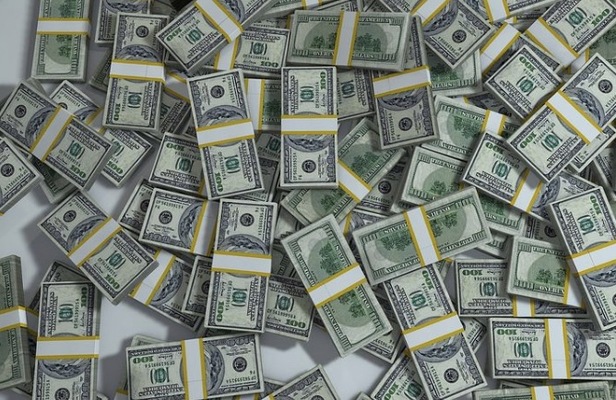
My dad's lawyer treated him like garbage. That taught me exactly how NOT to do this. I run my practice on three principles:
You deserve to have your calls answered. You deserve to know what's happening with your case. You deserve a lawyer who gives a damn.
When you work with me, you're not a number. Everyone on my team knows that winning your case while actually helping you is the whole point.
I call you back. I answer questions. I keep you in the loop. Sounds basic, but you'd be shocked how many lawyers don't do it.
Insurance companies know which lawyers can actually try cases and which ones can't. They pay more to the lawyers they're scared of.
I've spent over $100,000 on trial training. Gerry Spence's Trial Lawyer's College. KTI "The Edge" program. Not one in 10,000 lawyers has done the training I've done.
Why? So when we sit down to negotiate, they know I'm ready to take your case to trial and win. That gets you more money.
I have my own unique case management software. My own process for building cases before we even file suit. I discover more about your case earlier than other lawyers.
I get moving immediately:
Grab the police report Document the scene Talk to witnesses before they forget Lock down evidence Get your medical records Calculate what you're owed
I get ahead of the insurance company. That means better results faster.

Let me give you some real advice:
Right after it happens:
Call 911. Get cops there. Get checked out even if you feel okay. Adrenaline hides pain. Injuries show up later. Take photos of everything. The cars, the intersection, your injuries, the road. Get the other driver's insurance info and contact. Get witness names and numbers. Don't say it was your fault. Don't make statements about what happened.
After you leave:
See a doctor within 24 hours. Insurance companies use delays against you. Go to every appointment your doctor says. Keep everything—medical bills, prescriptions, days you missed work. Stay off social media. Seriously. They WILL look at your Facebook and Instagram. Don't talk to the other driver's insurance. They're not helping you. Call me at (312)-500-4500 BEFORE you sign anything.
The insurance company starts investigating right away. Looking for ways to deny your claim or pay less. You need someone on your side just as fast.
That's why I'm available 24/7. Call me right after if you can. Or call me later. Just call before you talk to their insurance company.
Find Out What YOUR Case Might Be Worth...for free.
Insurance companies aren't evil. But they are billion-dollar corporations trying to pay you as little as possible. It's just business to them.
Here's what they do:
Quick settlement offers. They call fast and offer you money. Sounds good? It's always way less than what you deserve. They're counting on you not knowing better.
Blame you. They'll say it was partly your fault. Even in a rear-end crash, they'll claim you stopped too fast.
Minimize your injuries. Say you're not really hurt. Point out you're smiling in a photo on Facebook, so you must be fine.
Drag it out. They delay hoping you'll get desperate and take less.
Surveil you. Sometimes they hire people to follow you around, trying to catch you doing something physical.
Recorded statements. They ask for one and twist your words later.
I've seen it all. That's why you never—ever—talk to the other driver's insurance without calling me first.
Call (312)-500-4500. I'll handle them while you focus on healing.
Car accidents cause all kinds of injuries:
Neck injuries. Whiplash to permanent damage needing surgery.
Back injuries. Herniated discs, compressed discs, spinal cord damage. Can affect you forever.
Head injuries. Concussions, traumatic brain injuries. More common than you think. Insurance companies love to minimize these.
Broken bones. Arms, legs, ribs, face. Need surgery, long recovery.
Shoulder injuries. Rotator cuff tears, dislocations. Affects everything you do.
Knee injuries. ACL tears, meniscus damage. Usually need surgery and months of PT.
Cuts and scars. Glass and metal cause serious cuts that leave permanent scars.
Internal injuries. Organ damage, internal bleeding. Medical emergencies.
Psychological injuries. PTSD, anxiety about driving, depression. Real injuries under Illinois law.
Don't let them tell you your injuries don't matter. Every injury deserves proper compensation.

There are lots of car accident lawyers in Chicago. I won't say I'm the only one who can help. But here's what makes me different:
I only represent injured people. Never insurance companies. Never the other side. Your fight is my fight.
You pay nothing unless I win. No upfront costs. Nothing. I pay for everything—medical records, experts, filing fees. You don't pay me back unless we win.
My fee is 33⅓% if we settle, 40% if we go to trial. Standard rates in Illinois. If I don't win, you pay nothing.
Call me anytime. (312)-500-4500. 24/7/365. Day, night, weekends, holidays. I'm available.
No pressure. I don't chase people. Don't use pushy sales tactics. We talk like friends. I listen. Answer questions. Tell you what I think. You decide. Either way, we end up as friends.
I have the training. Gerry Spence Trial Lawyer's College. KTI "The Edge." Insurance companies know I can win at trial.
I have the experience. I've handled thousands of cases. Represented accident victims all over Chicago. Recovered millions.
I take all cases. Some lawyers only want big cases. Not me. I believe once you work with me, even on a smaller case, you'll know you're with a serious lawyer who cares.
I know Chicago. The courts, judges, insurance companies. Where accidents happen and why. Local knowledge helps me win.

Yes, if you have any real injuries. Insurance companies pay more to people with lawyers—it's just a fact. They know which lawyers can win at trial.
Nothing upfront and no money out of pocket. I work on contingency (33⅓% if we settle, 40% if we go to trial). No win = no fee. I pay for everything—medical records, experts, filing fees.
Illinois has "modified comparative negligence." You can still recover. If you're less than 51% at fault, you can still recover. Your amount gets reduced by your percentage of fault, but you still get paid.
NO. Never. First offers are always too low. They're testing to see if you know better. Call me at 312-500-4500 before you sign anything.
Two years from the accident usually. Sometimes, one year. SOme cases have Notice requirements. There is no one easy answer. And there are exceptions. And evidence disappears fast. Call now. (312)-500-4500. Don't wait.
We look at your uninsured motorist coverage. Look for other liable parties. There are often options. Call me and we'll figure it out.
If you have any real injuries, yes. Even if you injuries aren't severe or don't last forever, you probably have a case. The bigger the injury, the more you have to lose without a lawyer. Insurance companies take advantage of people without lawyers. Having me changes everything.
Some settle in months. Others take longer, especially if we go to trial. I move as fast as possible while fighting for maximum money.
Most cases settle. But I'm always ready to go to trial if they won't be fair. They know that about me. Helps me get better settlements.
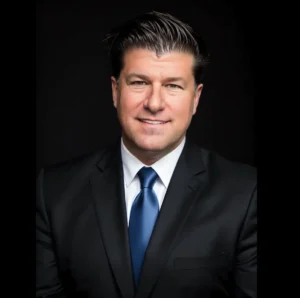
Chicago neighborhoods: Loop, Lincoln Park, Wicker Park, Lakeview, Logan Square, Hyde Park, Bridgeport, Pilsen, Bronzeville, South Shore, Rogers Park, Andersonville, Ravenswood, Lincoln Square, West Town, Bucktown, Old Town, Gold Coast, River North, Streeterville, South Loop, West Loop, Englewood, Austin, Humboldt Park, Albany Park, Edgewater, Ukrainian Village, North Center. Everywhere.
Suburbs: Evanston, Skokie, Oak Park, Berwyn, Cicero, Naperville, Aurora, Joliet, Schaumburg, Des Plaines, Park Ridge, Elmhurst, Wheaton, Downers Grove, Hoffman Estates, Palatine, Arlington Heights. All of them.
Highways: Kennedy, Dan Ryan, Eisenhower, Lake Shore Drive, I-90, I-94, I-290, I-294. All Chicago-area highways.
My main office is in Oak Brook, Illinois, with free parking and easy access. My downtown Chicago office is right across from the courthouse. But I'll meet you wherever—your house, hospital, coffee shop, wherever you're comfortable.
Call me. (312)-500-4500.
Hiring Scott was one of the best moves I have made in my life. Scott is a down to earth person and attorney. Scott is a 5 star first class act who really knows his stuff. The Judge said his presentation was one of if not the best he had ever seen. Take my advice, hire Scott I’m sure you’ll be 200% satisfied I was.

Scott not only cares about the case, but he truly cares about his clients and that makes him the best lawyer I have ever met and hired! He won my case! He is thorough in everything he does. I highly recommend Scott, and will always refer him to family and friends.

I hired Scott DeSalvo upon a friend’s recommendation. His office kept me informed of developments as they happened, and I felt the settlement reached was fair considering my injuries. I would highly recommend Scott DeSalvo to represent your personal injury case.

Call Me Right Now If You Need A Car Accident Lawyer in Chicago
Look, I know this sucks. Car accidents are scary. You're hurt. Worried about bills. Worried about missing work. Dealing with insurance companies that don't care.
I get it. And I want to help.
But time matters. Evidence disappears. Witnesses forget. Insurance companies start building their case against you right away. And you only have two years in Illinois to file.
Don't wait. Don't handle this alone. Don't let them take advantage of you.
Call me right now. (312)-500-4500.
Doesn't matter what time it is. I'm available 24/7/365.
Call's free. Consultation's free. We talk like friends. No pressure, no games. Just honest answers.
I'll tell you straight if I think you have a case and what it might be worth. Then you decide if you want to hire me. Your choice.
And remember: you pay nothing unless I win. I cover all costs. No money out of pocket. No risk.
You already went through the crash. Now let me fight to get you what you deserve.
Call (312)-500-4500 right now.
Your fight is my fight. Let's do this together.

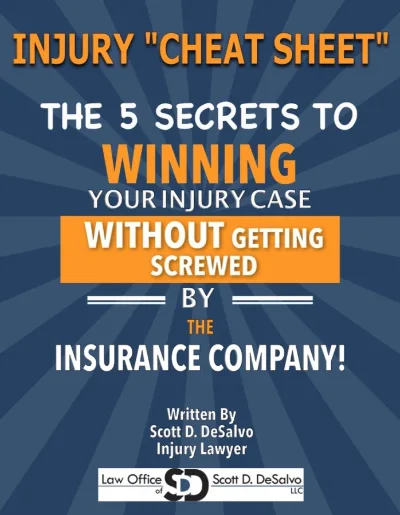

Scott DeSalvo founded DeSalvo Law to help injured people throughout Chicago and surrounding suburbs. Licensed to practice law in Illinois since 1998, IARDC #6244452, Scott has represented over 3,000 clients in personal injury, workers compensation, and accident cases.
No Fee Unless You Win | Free Consultation | 24/7 Availability Call or Text: (312) 500-4500
>>Read More
Main Office:
1000 Jorie Blvd Ste 204
Oak Brook, IL 60523
New Cases: 312-500-4500
Office: 312-895-0545
Fax: 866-629-1817
service@desalvolaw.com
Chicago and Other Suburban Offices
By Appointment Only